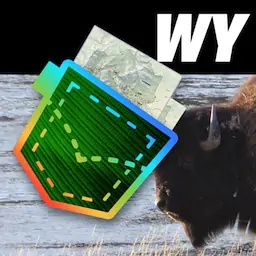"Grand Teton, Moose Entrance" by U.S. National Park Service , public domain
Elk Ecology & ManagementNature |
Elk Ecology & Management brochure for Grand Teton National Park (NP) in Wyoming. Published by the National Park Service (NPS).
featured in
| National Parks Pocket Maps |  | |
| Idaho Pocket Maps |  | |
| Wyoming Pocket Maps |  | |
| Yellowstone Pocket Maps |  |
Grand Teton
National Park Service
U.S. Department of the Interior
Grand Teton National Park
John D. Rockefeller, Jr.
Memorial Parkway
Elk Ecology & Management
"Often from out of the forest, as I sit here
writing, comes the long clear bugle note
of a bull elk…These are the adventures of
the wilderness, the scenes which make up
Nature's great mosaic. Why do we so delight
in the wild creatures of the forest, some of us
so passionately that it colors our whole life."
Olaus Murie, Wapiti Wilderness.
Jackson Elk Herd
Tens of thousands of elk live in the Greater Yellowstone Ecosystem, a 20 million
acre area including Grand Teton and Yellowstone national parks, the John D.
Rockefeller, Jr. Memorial Parkway, seven national forests and two national wildlife
refuges. We call elk in these areas the Jackson elk herd. Management of the herd is
challenging and involves a reduction program in the form of an annual harvest.
Physical Characteristics
Elk are ungulates (hooved-animals) belonging
to the deer family. Elk have a dark head, neck
and legs, with a lighter brown body and a creamcolored rump. Wapiti, the Shawnee name for elk,
means white rump. Females are darker than males.
tissue composed of blood vessels that nourish
developing antlers. Antlers are cartilage-like
during formation, but later become bone. When
fully developed, bulls rub off the velvet by scraping
their antlers against saplings.
Mature males have branched antlers, whereas
yearling males have “spikes.” Antler size indicates
dominance and nutritional state. Females do not
have antlers. Older males shed their antlers in
March and April, while younger bulls shed their
antlers later. New antler growth begins within
a week and continues until late August. At their
peak rate of growth, “velvet” covered antlers may
grow almost one inch per day. Velvet is fuzzy
•Adult males weigh about 700 pounds; adult
females weigh about 500 pounds.
•The breeding period, called the rut, occurs from
early September to mid-October.
•The gestation period is 8-1/2 months; one calf
is born in late May and June. Newborns weigh
30 pounds at birth and 250 pounds at the end of
their first summer.
•The average life span is 13 to 18 years.
During the severe winter 1908-1909, thousands of
elk died due to heavy snows and lack of access to
winter range. Elk raided rancher's hay stored for
livestock causing conflicts. In 1912, the National
Elk Refuge established secure winter range. Today
the refuge covers 24,700 acres of native grasses.
In the summer, elk from the refuge migrate up to
60 miles to Grand Teton and Yellowstone national
parks and the Bridger-Teton National Forest.
National Elk Refuge
When snow becomes crusty or deep, elk struggle
to reach their food and the refuge provides a
supplement of alfalfa pellets. Elk stay on the refuge
for about six months with about two and a half
months of supplemental feeding. Winter mortality
on the refuge is 1 – 2 percent; but ranges up to 20
percent outside the refuge.
Elk Annual Cycle
During autumn, males establish harems of females
to mate with and zealously guard. Bulls bugle, a
high-pitched whistling sound, followed by grunts,
as a display of dominance to attract females and
assert their rank. Rival males respond by bugling
back. Bulls may spar with challengers, after first
aggressively posturing and thrashing the ground
with their antlers.
Females enter estrus (breeding receptivity) for a
twelve-hour period. Estrus may recur up to four
times at twenty-day intervals until successful. 85 to
90 percent of females become pregnant each year.
The rut is an intense time for bulls. Dominant
males expend a considerable amount of energy
and rarely eat. The price for passing on their genes
means bulls enter winter severely depleted.
Reduced food supplies and snowfall in the high
country prompt elk to leave their summer range.
Beginning in October, elk migrate from summer
grounds to winter grounds. Elk paw through snow
to reach forage.
Elk are susceptible to a number of diseases
including brucellosis and chronic wasting disease.
Brucellosis is a contagious bacterial disease that
originated in livestock and often causes infected
cows to abort their first calves. An average of 30
percent elk on feed-grounds have tested positive
for exposure to brucellosis. Chronic wasting
disease is a contagious fatal disease with no
known vaccine that has spread within 130 miles of
Yellowstone National Park.
As snow melts in early spring, elk stream off
the refuge. They follow new vegetation as they
return to their traditional summer range in higher
elevation meadows; 2,500 elk summer in Grand
Teton National Park. Females give birth to calves
on their summer range or while migrating. Cows,
calves and yearling males remain in small groups
throughout the summer, while older males, form
bachelor herds.
Summer is a brief time of plenty. Elk are primarily
grazers—they eat lush grasses and wildflowers,
although when food is scarce, they will browse on
woody shrubs and saplings. Elk eat at dawn and
dusk, and spend warm days in the cool shade of
forests as they ruminate (chew their cud). After
birth, females leave their nearly scentless spotted
calves curled up as they feed some distance away.
Within a week or two, calves follow their mothers.
By late summer, bulls' testosterone levels increase
resulting in the end of antler development and the
start of the rut. As fall colors peak, the haunting
sound of bugling elk fills the air…
Population Regulation
Female elk first breed as yearlings or as two
year olds. Females usually have one calf per
year until they die. 50 percent of juveniles do
not survive their first year. Elk have a high
reproduction potential: a ten-year old female
may account for five living descendants, a five
fold increase in the population.
Flagg Ranch
JOHN D. ROCKEFELLER, JR.
MEMORIAL PARKWAY
Shading indicates
area open to
hunting
89
287
North
Hunt Camp
Park hunt camps, open only to hunters with
a valid permit, are located at Pacific Creek
and at Pilgrim Creek. Hunters may not camp
elsewhere in the park. Hunters that kill an elk
must hang the meat at least ten feet high from
the racks at the hunt camps or remove the meat
immediately to prevent black and grizzly bears
from claiming the carcass.
Special Precautions
Hunting, by nature, is an activity that increases
the risk of a bear encounter. Hunters typically
move quietly through the woods, with the wind
in their face. Hunters are required to carry an
accessible can of bear spray while hunting.
Research shows bear spray is highly effective
during a bear encounter.
Hunting in the Rockefeller Parkway
Grand Teton National Park administers the
24,000-acre John D. Rockefeller, Jr. Memorial
Parkway, but Wyoming State law governs
hunting regulations. Hunting elk and several
other species occurs throughout the parkway
September 1-December 31. No wolf or bison
hunting is allowed in the parkway.
Poaching
Abundant wildlife in the park attracts
poachers. If you witness illegal activity, do not
take action. Note the location, descriptions
of the individuals, vehicle plate numbers and
descriptions. Report the incident as soon as
possible. In the park, call 911 or (307) 739
3301. Call (877) 943-3847 to report poaching
outside the park.
im
gr
Pil
PARK
R
d
JACKSON
LAKE
C
k
NATIONAL
Two Ocean
Lake
Area
79
ac
fic
Colter Bay
P
C k Rd
i
Moran
Signal
Mountain
Lodge
26
89
191
Leigh
Lake
26
287
Area
79
River
Bottom
Triangle X
Ri
ve
r
Jenny
Lake
e
The Elk Management Program
Hunting occurs in the park October to earlyDecember. From Moose to Moran, hunt areas
are east of the Snake River. North of Moran
Junction, hunting occurs east of Highway 89
and throughout the John D. Rockefeller Jr.,
Memorial Parkway.
Area 71
ak
The National Park Service and the Wyoming
Game and Fish Department jointly manage the
elk population within Grand Teton National
Park. In 1950, Public Law 81-787 established
the present boundaries of Grand Teton
National Park. Congress included a provision
to manage the elk population through an
annual elk reduction program when necessary.
According to this law, hunters selected to
participate in the reduction must have legal
Wyoming hunting licenses for special areas 75
and 79 and must be deputized as park rangers.
TETON
Bridger
Teton
National
Forest
Sn
Elk Management Program
GRAND
Teton Wilderness
Bridger-Teton
National Forest
Area
75
Teton
Science
Schools
Moose
Hayfields
Blacktail
Butte
26
89
191
os
Gr
Winter mortality, disease and predation reduce
the elk population, as does hunting. The
National Elk Refuge manages the land as winter
range for elk and bison. 90 percent of the
Jackson elk herd winter on the refuge (5,000
to 8,000 elk) or on three state-operated feed
grounds in the Gros Ventre River drainage.
The Jackson elk herd population is 11,050 elk
(2012), close to the objective of 11,000.
Ve
e
ntr
Kelly
er
Riv
National
Elk
Refuge
Changes Implemented in 2013
BEAR
AWARE
For Your Safety
During the elk reduction program,
hunting is prohibited within 1/4 mile of
U.S. highways 26, 89, 191 and within 1/2
mile of buildings. Some parts of Area 75
have a 1/4-mile
posted closure. Shooting
BEAR
is permitted
adjacent to secondary roads
AWARE
within areas open to hunting with hunters
KEEP
FOOD
at least 30 feet
from the roadway.
FOOD
STORAGE
• Hunters will be limited to seven non-lead
STORED
Hiking isREQUIRED
not recommended in areas
cartridges per day.
• Limiting the number of shots fired by a
hunter at a group of running elk to one.
• Closing the portion of the Snake River
bottom between the Deadman's Bar
road and Ditch Creek to decrease the
probability of grizzly bear-hunter
conflicts in an area of thick timber and
poor visibility.
• Opening the area between the Gros
Ventre River and the road to Kelly,
adjacent to the National Elk Refuge
between Gros Ventre Junction and
a point just west of the Gros Ventre
campground to hunting.
• Opening Hunt Area 79 to Hunt Area 75
Type 4 (antlerless) license holders for
two weeks at the beginning of the season
to focus on Grand Teton summerresident elk and to spread out hunters.
E X P E R I E N C E Y O U R A M E R I C A™
of the park and parkway adjacent to or
within hunt areas. If you do hike in these
areas, please wear flourescent orange.
Also, the park recommends that all hikers
carry bear spray. Consult a map or check
at the Craig Thomas Discovery and Visitor
Center in Moose for recommendations.
• Watch for animals on the road,
especially at night. Elk, moose, bison
and mule deer frequently migrate at
night and may be difficult to see.
• Be Bear Aware!
• Follow proper food storage
requirements. When not in immediate
use, store all items with an odor (e.g.
food, toiletries, cookware, etc.) in a
bear-resistant food storage locker or in a
hard-sided vehicle with the doors
locked and windows closed.
Rev. 10/14
F
STO
REQ




